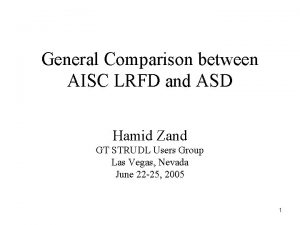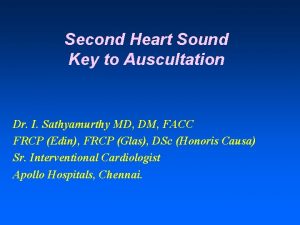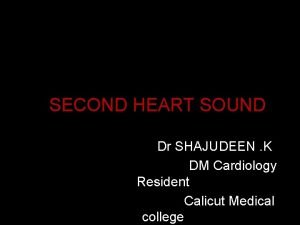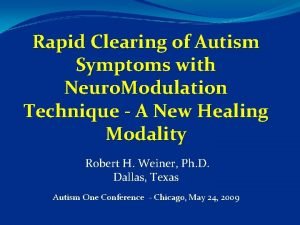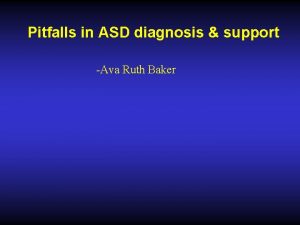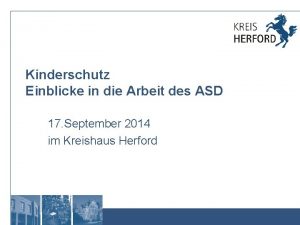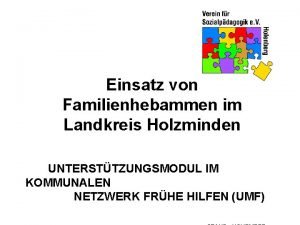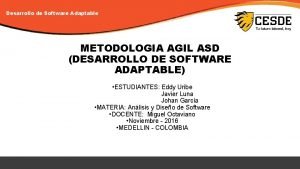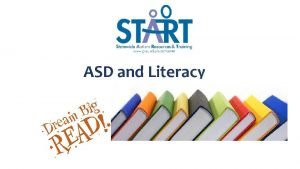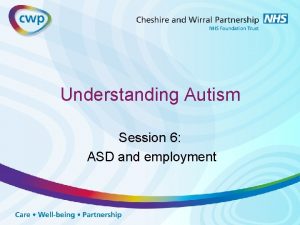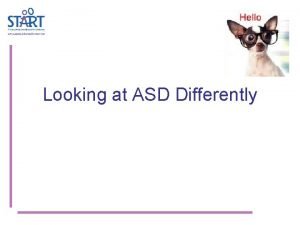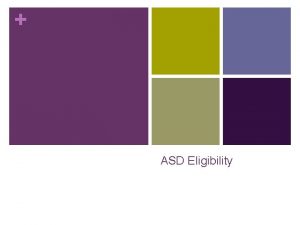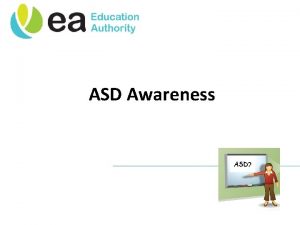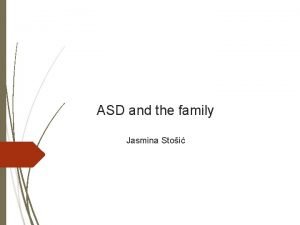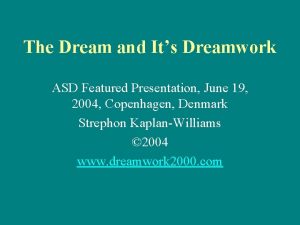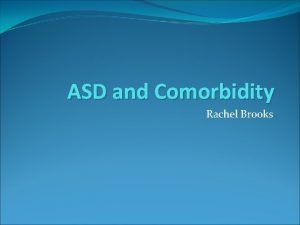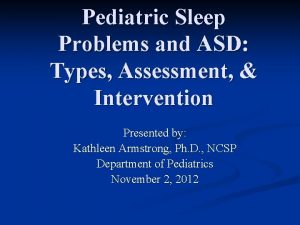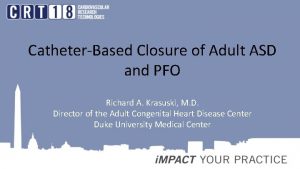ASD What is ASD and how do we
















- Slides: 16

ASD What is ASD and how do we manage it?

What do you think it is? • Talk to your neighbour and share your experiences and knowledge

Official Definition • Autism spectrum disorder (ASD) is a condition that affects social interaction, communication, interests and behaviour. • In children with ASD, the symptoms are present before three years of age, although a diagnosis can sometimes be made after the age of three. • It's estimated that about 1 in every 100 people in the UK has ASD. More boys are diagnosed with the condition than girls.

Triad of impairments • • • social relationships social language and communication skills Imagination And now – sensory difficulties Can also affect ability to process so visual cues are vital

Aliens amongst us • Difficulty reading expression • Difficulty relating one learned behaviour with another • Difficulty processing quickly enough to respond • Difficulty understanding empathy/mind reading

emotions • • Imagine being lost in a strange land You don’t speak the language You don’t recognise the societal norms Others communicate by reading minds Things lunge at you randomly Lights are too bright, noises too loud How would you feel?

sensory • Sensory issues can affect children in different ways: • Too sensitive (hyper sensitive) • Under sensitive (hypo sensitive) • Children can hae complex sensory issues

language • Can be affected • Understanding the words but not using them properly (semantic/pragmatic) • Social language • Can be SLCN

What can we do? • • • Calm area Routines Make it visual Warn of change Safe place/quiet area Prepare in advance for non-compliance and have visual cues to help guide back.

Now/next board Now Next Writing time Lego time reward

Visual aids • Cartoon conversations • Timers • Task management boards • Facial expressions

PDA • Pathological Demand Avoidance • Linked to ASD • People with Pathological Demand Avoidance Syndrome (PDA) will avoid demands made by others, due to their high anxiety levels when they feel that they are not in control. • PDA is increasingly recognised as part of the autism spectrum.

Maiin features • he main features of PDA are: • Obsessively resisting ordinary demands • Appearing sociable on the surface but lacking depth in their understanding (often recognised by parents early on) • Excessive mood swings, often switching suddenly • Comfortable (sometimes to an extreme extent) in role play and pretending • Language delay, seemingly as a result of passivity, but often with a good degree of 'catch-up' • Obsessive behaviour, often focused on people rather than things.

What does it feel like? • When I do come in to school I want to work but once something happens to throw me off it is like a switch is flipped and I just want to go home. This could be a student coming into my room or an unexpected change. Once I feel like this I can’t get my mind back on to work and I just get focused on wanting to go home.

What can we do? • A very non confrontational approach in terms of managing behaviours • To be as pro-active as possible in order to avoid stressful situation for the pupils • To be flexible, creative and imaginative when devising individual programmes. • To be as consistent as possible with each individual pupil • To give a degree of responsibility to the pupils in relation to their own learning • To recognise and accept that the pupils are generally ‘not trying to get away with things, or are trying to be devious’ • To involve parents/carers as much as possible in any management issues

Helpful websites • http: //www. pdasociety. org. uk/what-is. PDA/autism-and-aspergers • http: //thegirlwiththecurlyhair. co. uk/ • http: //www. templegrandin. com/ • http: //www. nassurreybranch. org/home. html
 Difference between lrfd and asd
Difference between lrfd and asd Asd
Asd Reverse split s2
Reverse split s2 Fixed splitting of s2
Fixed splitting of s2 Pddbi score interpretation
Pddbi score interpretation Dr ava ruth baker
Dr ava ruth baker Asd herford
Asd herford Asd holzminden
Asd holzminden Asd metodologia
Asd metodologia Tetralogy of fallot murmur
Tetralogy of fallot murmur Wake tech admissions
Wake tech admissions Committee 3000
Committee 3000 Committee 3000
Committee 3000 Simplified technical english
Simplified technical english Ostiun
Ostiun Secundum asd
Secundum asd Sensory processing disorder dsm
Sensory processing disorder dsm
